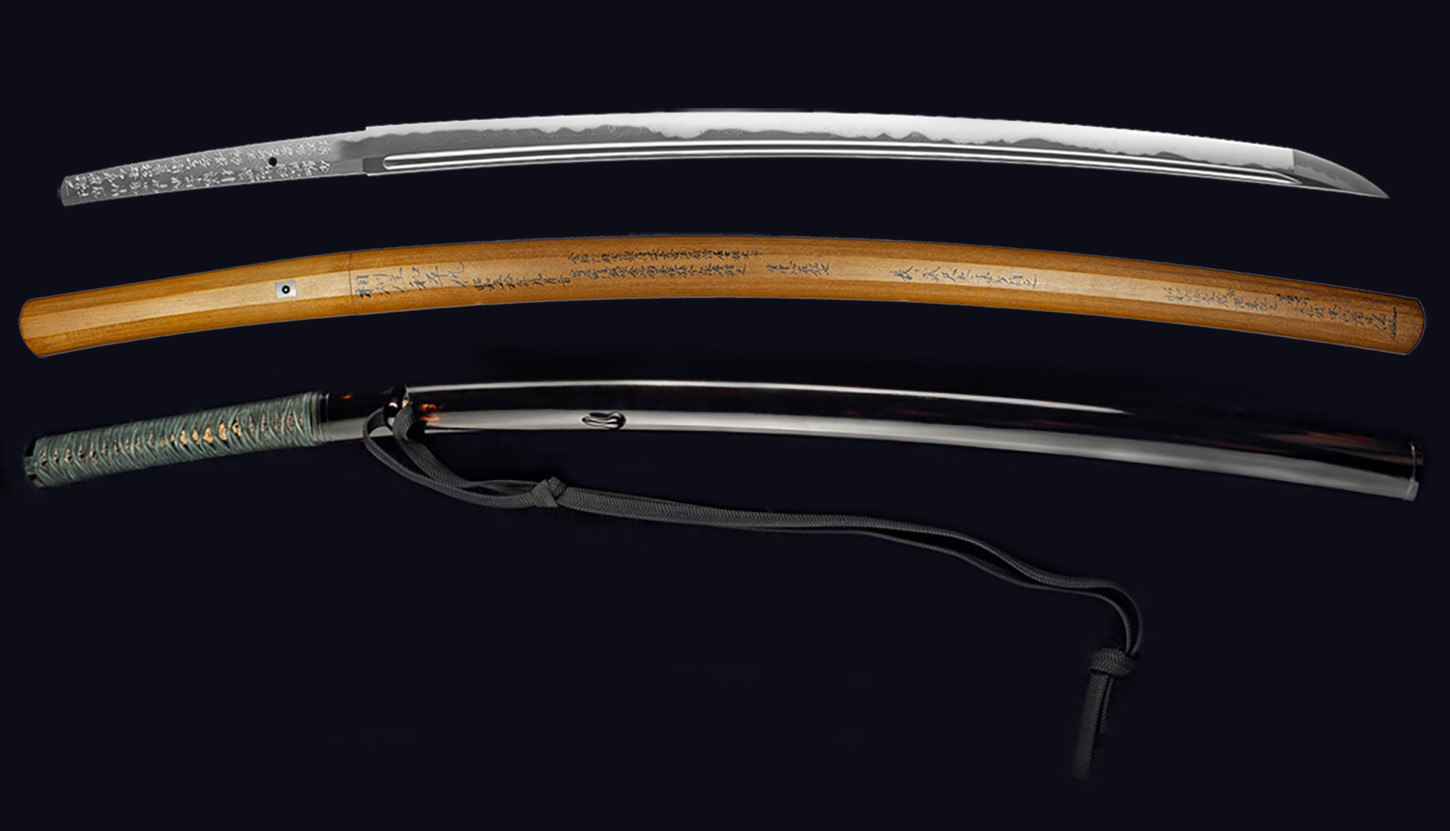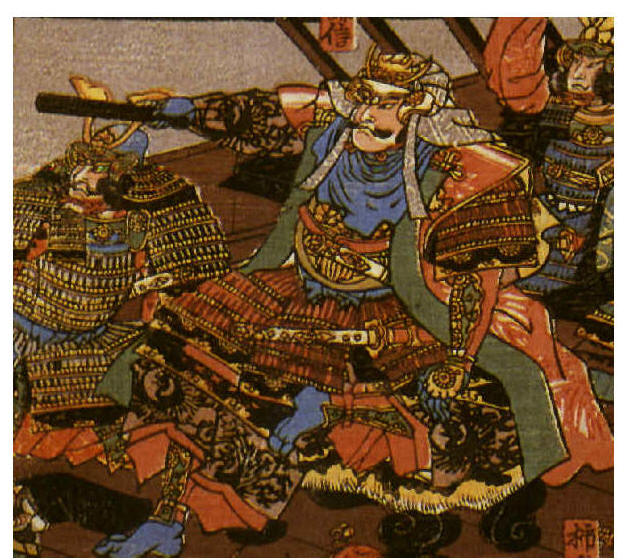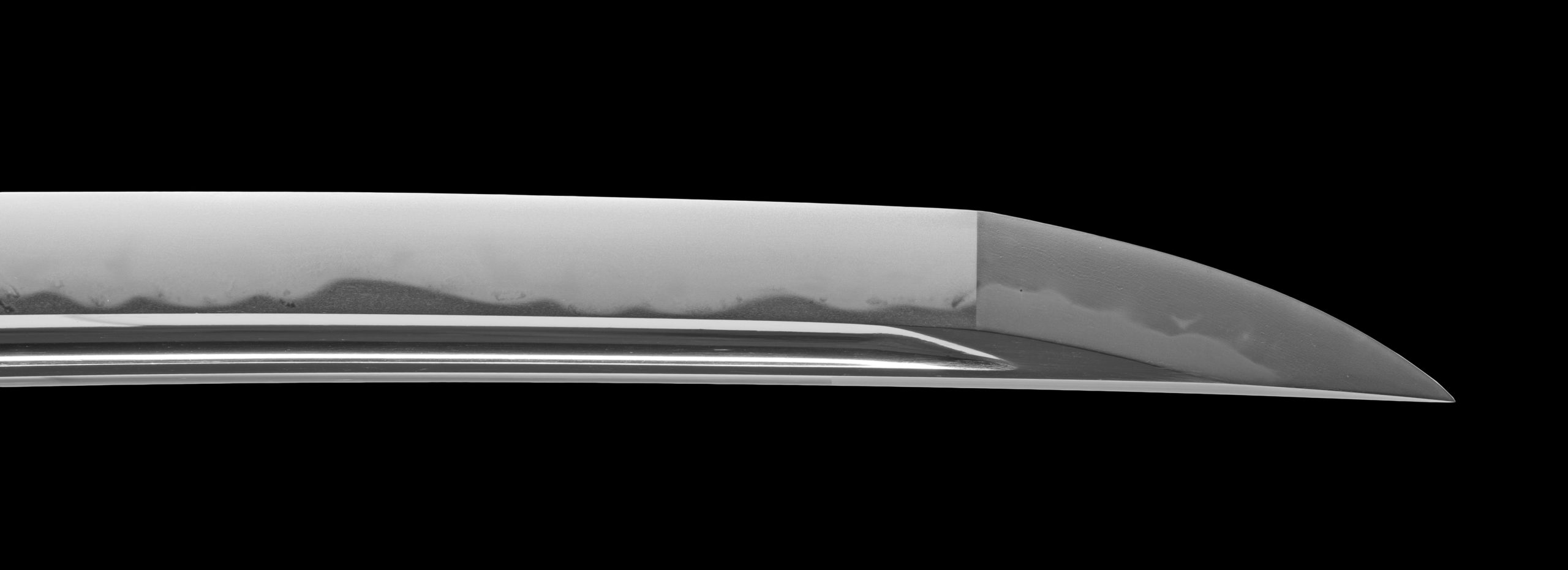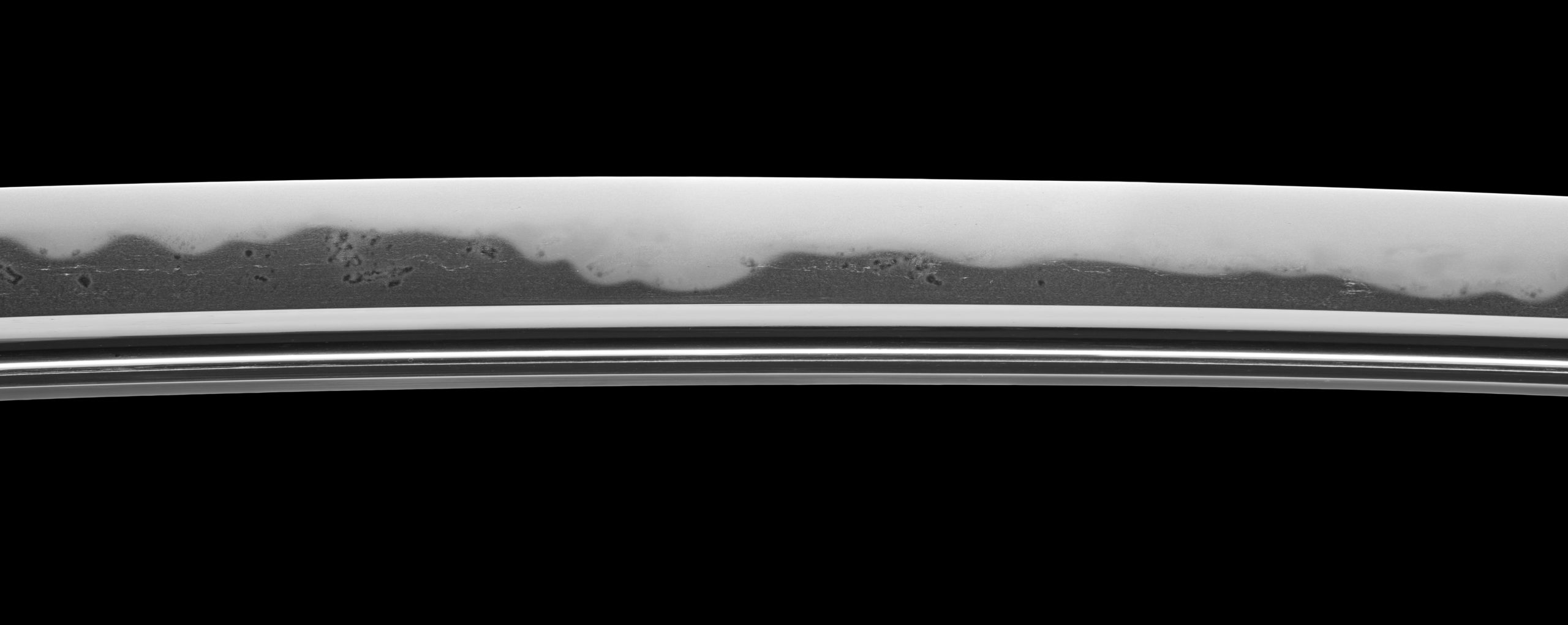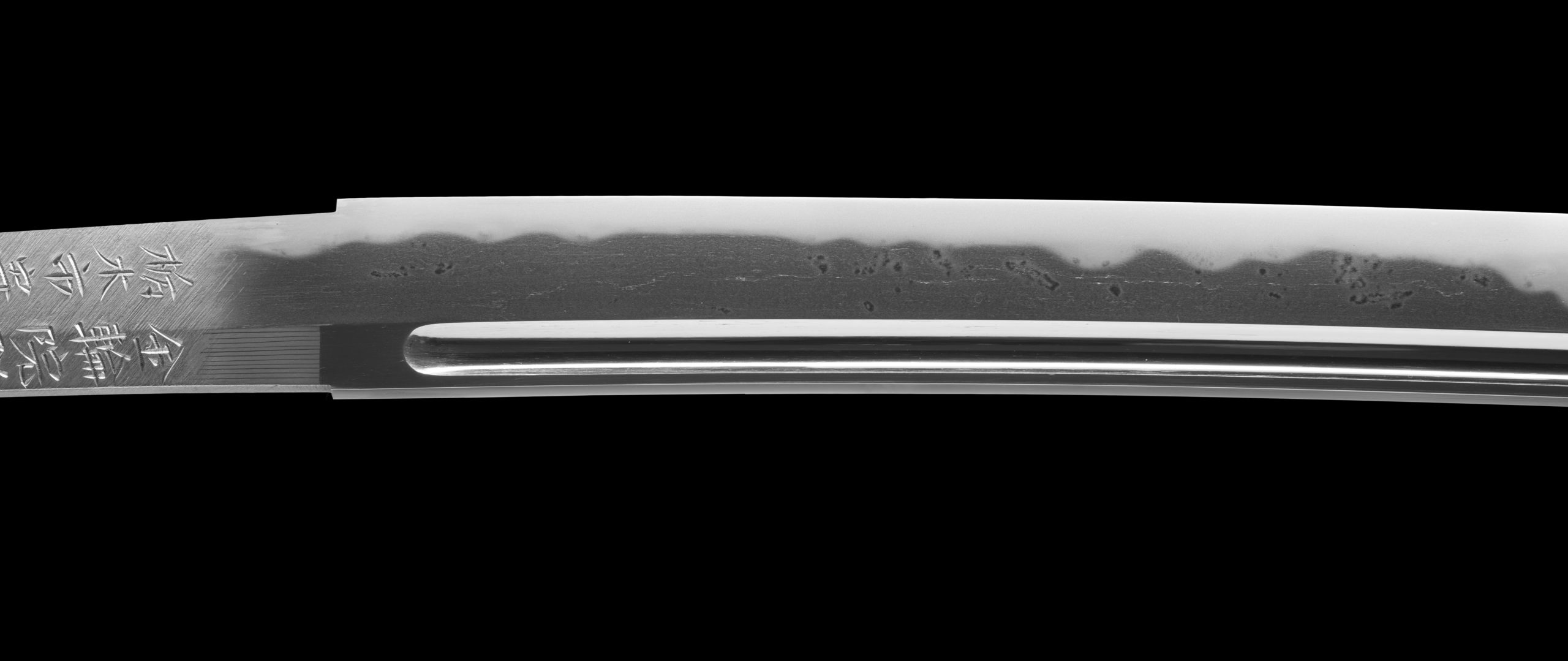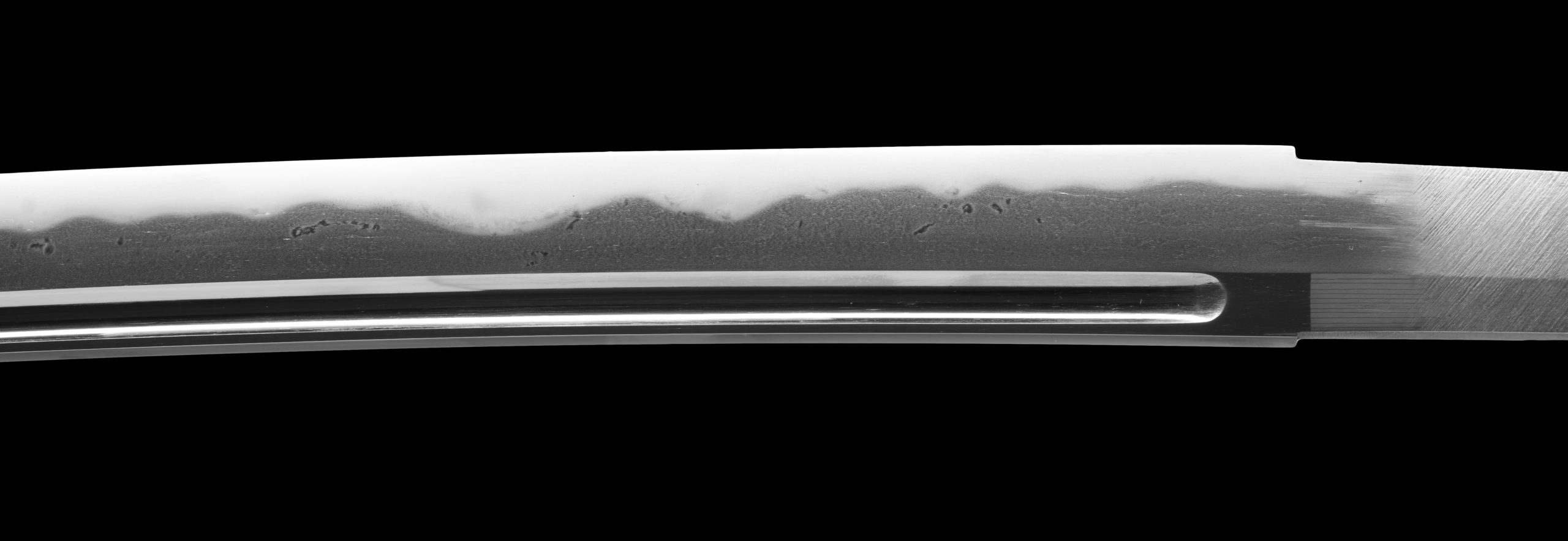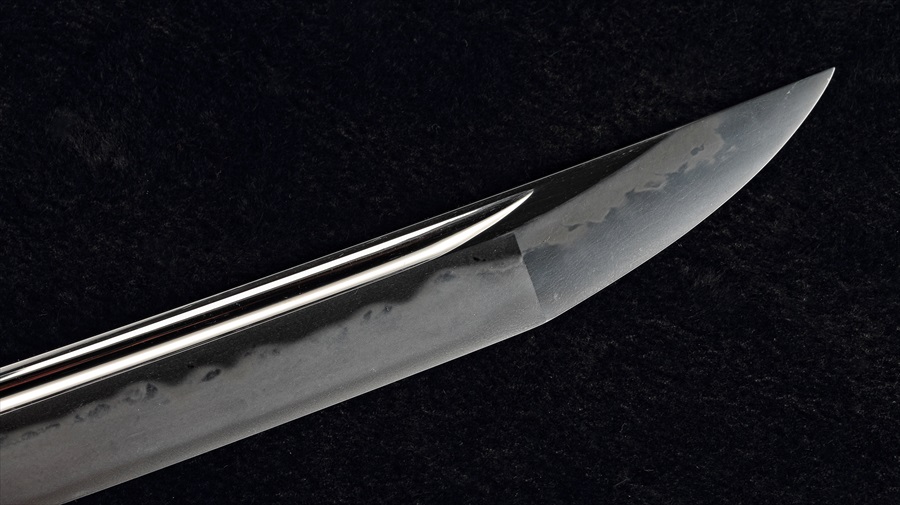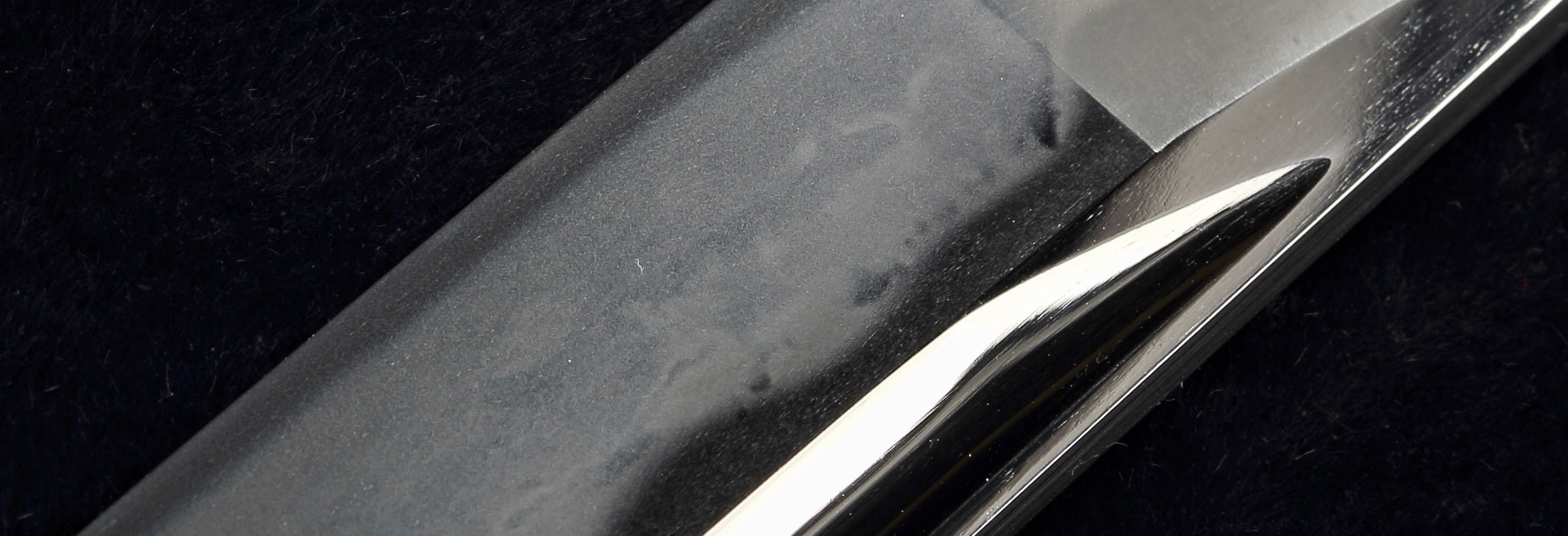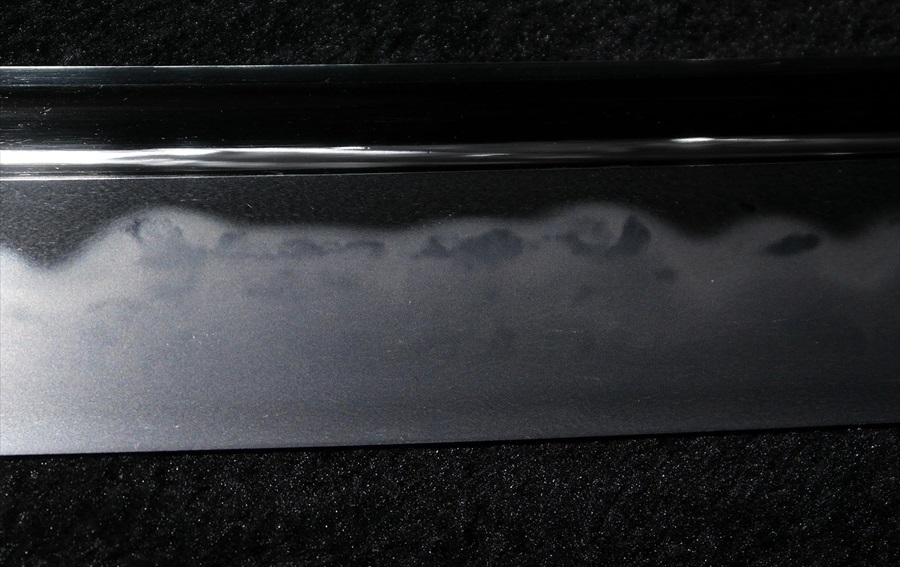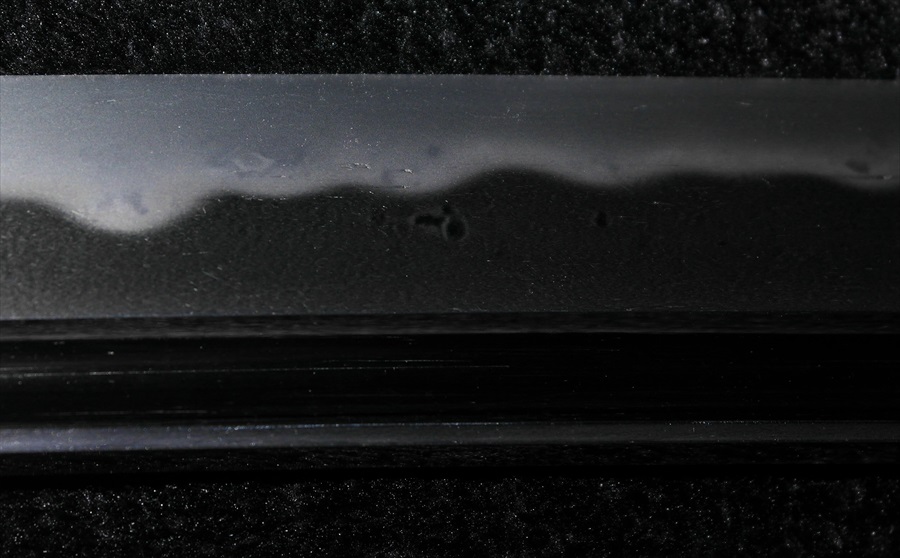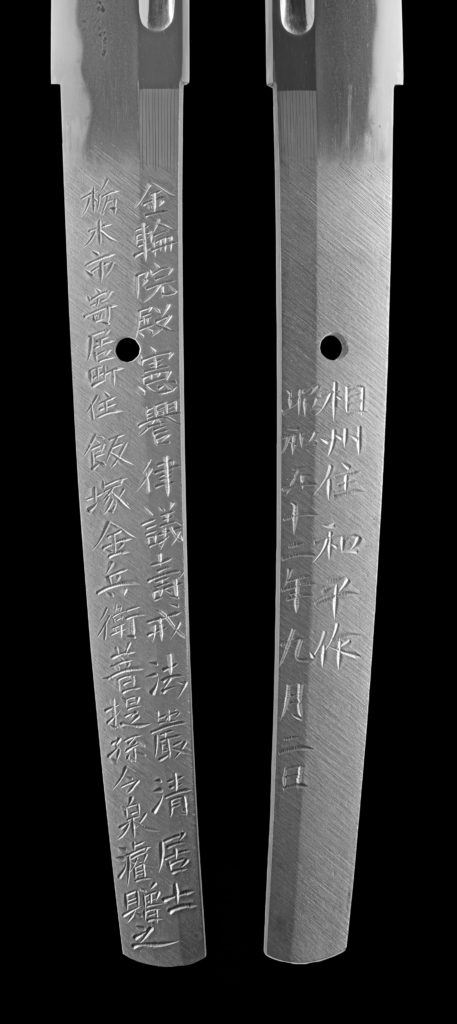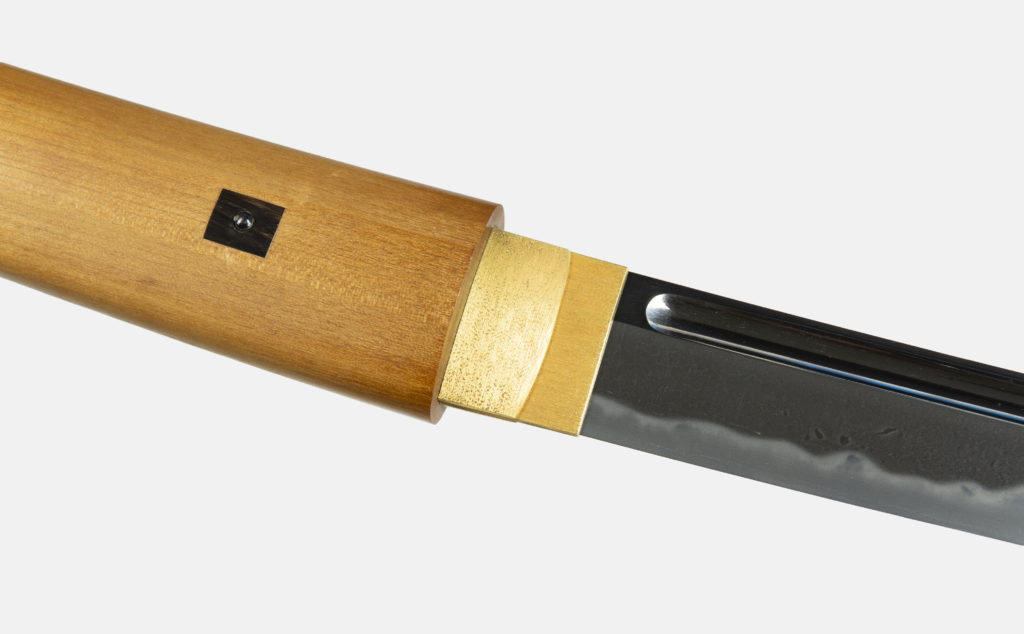A tachi by Okubo Kazuhira – recreation of
kokuhō (Nat’l Treasure) “Sanchomo” Yamatorige Ichimonji
Polished by Hon’ami Nisshu* (Living National treasure)
w/ his saya-gaki
Mukansa* “Without Judgment”
Swordsmith: Okubo Kazuhira
(Wahei) The top student of Miyairi Akihira
the first living national treasure.
Classification: (shinsakuto) tachi
Nagasa (cutting edge length): 28 7/8″ ~ 73.3 cm Sori (curvature): 2.73 cm [tori-sori] Motohaba (width): 3.3 cm
Hada: Ko-itame with chikei and ji nie
Hamon: Nie deki o-choji midare
Tang translation-
Omote: Kinrin’in-dono Ken’yo Ritsugi Jukai Hogon seikoji
Tochigi-shi Yoriimachi-ju lizuka Kinbei bodai-son Imaizumi Shun kore o okuru
Ura: Soshu-ju Kazuhira saku Showa 52nd year , 8th month, 2nd day (1977, 2nd day of Aug.)
The devout layman Kinrin’in Ken’yo Ritsugi Jukai Hogon.
Gift by Imaizumi Shun from Yoriimachi in Tochigi City, descendant of the enlightened Iizuka Kinbei.*
* According to tradition, Iizuka Kinbei was the father of lizasa Ienao 飯篠家直 (1387 – 1488), the founder of the Tenshin Shoden Katori Shinto-ryu*.
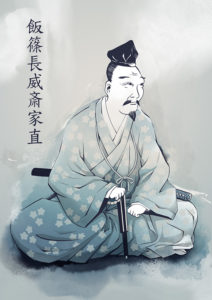
*Tenshin Shoden Katori Shinto-ryu is one of the oldest military art schools in Japan. As a school admired for its high standard of technique it has been very influential in the foundation of other schools. It was established by Lizasa Chouisai about 560 years ago. He was born in Lizasa-village (Take town, Chiba Prefecture) 1387 AD. After an intensive period of both mental and physical ascetical practiced at Katori Jingu, he had mastered the secret of military arts. The school has been inherited from his age through today by his posterity.
Photo (left): 飯篠家直 lizasa Chōunsai Ienao (1387-1488) Source: Wikipedia Japan
Nakago: Ubu, 1 mekugiana
Saya-gaki: written by Hon’ami Nisshu in the spring of 1986 with his kaō (signature), a Ningen kokuhō (Living National Treasure).
Translation:
Soshu-ju Kazuhira saku
Second day of the ninth month Showa 50 (1975) [typo on saya-gaki: should state 1977]
The devout layman Kinrin’in Ken’yo Ritsugi Jukai Hogon.
Gift by Imaizumi Shun from Yoriimachi in Tochigi City, descendant of the enlightened Iizuka Kinbei.
[Blade has an] ubu-nakago and is signed.
Written by the juyo-mukei-bunkazai Hon’ami Nisshu in spring of 1986, year of the tiger + kao
Fukuro-gaki (袋書), sword bag writing: written by a priest in Japan 1992, it confirms the name of sword owner at the time, Mr. Imaizumi Shun. It states “Yu-ken” (Grand Sword).
Certificate: Guaranteed to pass NBTHK Hozon (a sword Worthy of Conservation by the Society for the Preservation of the Japan Art Sword)
Included: aikuchi (合口) koshirae, Shirasaya, and carry bags
-Price On Request.
This tachi was made by Okubo Kazuhira (born Okubo Towazu, 1943, died 2003). Kazuhira was the top student of Miyairi Akihira, the first national living treasure. Kazuhira was granted Mukansa at Heisei 12 (2000 AD) however passed away 3 years later. This tachi was made August 2nd 1977 prior to his gaining Mukansa status. It is a recreation of the famous Yamatorige (Yamatorige) Ichimonji that was once owned by Uesugi Kenshin (Nagao Kagetora, born February 18th 1530 – died April 19th 1578). An offer of 5 million USD was once made for the original kokuhō Yamatorige (Yamatorige) Ichimonji (nicknamed “Sanchomo”), it remains in a private collection at this time. The living national treasure Hon’ami Nisshu polished the blade and wrote the saya-gaki. The high quality koshirae was made by the top craftsman in Japan at the time (believed to be Mr. Watanabe). It is made in the style of the original that was owned by the Daimyo (Lord) Uesugi Kenshin, with the scabbard being covered in leather then lacquered black. The tsuka-ito quality is excellent. Uesugi Kenshin, from the Echigo province, was known as Dragon of Echigo, God of War, Tiger of Echigo & Guardian of the North. The former owner and whom this sword was made to honor are descendants of the enlightened Iizuka Kinbei, whose father Iizasa Chōisai Ienao (飯篠 長威斉 家直, c.1387 – May 26, 1488), was the the founder of Tenshin Shōden Katori Shintō-ryū (one of the oldest military art schools in Japan).
See the article by Markus Sesko further below showing images of the national treasure (kokuhō) Yamatorige-Ichimonji along with its aikuchi koshirae.
Uesugi Kenshin
“Uesugi Kenshin was one of the most renowned warlords of the 16th Century, a colorful figure who combined a love of campaigning with a thirst for learning and a genuine sense of honor. A devout religious man, Kenshin would never marry nor produce off-spring. Buddhist vows did not, however, prevent him from acquiring a taste for drink, which he consumed in copious amounts during his lifetime and may well have contributed to his early demise.” (There is much more to read at Samurai-Archives.com* about Uesugi Kenshin, including an extensive write-up about his various battles) *Samurai-Archives.com is inactive.
Original cost was at the time of making was about $55,000 USD, all custom ordered by Mr. Imaizumi a very big and famous collector, in the honor of his grandson passing, see tang translation described above here. The habaki is gold foil. The sword bag has fukurogaki by a priest, written in 1992, confirms the name of owner, Mr Imaizumi Shun. It states “Yu-ken” (Grand Sword).
“Towazu’s family were not smiths, and he himself developed an interest in forging swords whilst still at school. In 1961, after reading in a newspaper about the smith Miyairi Akihira, he set off alone to locate Akihira and learn about sword-making from him. Towazu travelled to Akahira’s hometown of Sakaki, a full day’s journey by train from his home in Kanagawa Prefecture, without letting his parents know of his intentions. The newspaper article did not give Akahira’s address, and so Kazuhira wandered along the Shinano River until nightfall, when he slept rough. In the morning, he was able to get directions to Akahira’s house from a local farmer.[1][2]
Akahira accepted Towazu as a student. Originally Towazu intended to return to finish his schooling, but Akahira discouraged him, pointing out that a high-school diploma was unnecessary to become a swordsmith. Towazu gained his swordsmith’s license in 1967 and took the smith-name Kazuhira (derived by combining characters from his birth name and his teacher’s name).[1]
He returned to his parents’ home and set up a smithy there. At the age of 23, he was severely injured when a fragment of a large stone anvil hit him in the face. He was forced to retire from work until fully recuperated.[1]
Over time, Kazuhira moved away from the Soshu style of his teacher, and began to forge swords in the Bizen style. Working in this style, he took first prize at the All Japan Swordsmith Association Awards in 1993 and the NBTHK Chairman’s Award in 1995.[1][2]“
Quotation from Wikipedia: Courtesy [1] Kodansha International. May 2002. pp. 103-107. ISBN 978-4-7700-2854-9 & [2] Leon Kapp; Hiroko T. Kapp; Yoshindo Yoshihara (2002). Modern Japanese Swords and Swordsmiths: From 1866 to the Present. Kodansha International. pp. 157. ISBN 978-4-7700-1962-2.
The sayagaki was written by Hon’ami Nisshu in the spring of 1986 with his kaō (signature), a Ningen kokuhō (Living National Treasure), his given name was Takeo and he died in July, 1996. He was the eldest son of Hirai Chiba and was adopted by Hon’ami Ringa in 1924. He was designated as Ningen Kokuho in 1975 along with a fellow polisher Ono Kokei. It was the first designation from the field of sword polishing. Master Hon’ami Nisshu was the 17th master of a long family tradition of sword polishers and connoisseurs who had served the Imperial court as well as the clans of Tokugawa and Nobunaga, major warlords of Japan warrior period. Also they served for Shogun Ashikaga and Maeda family having a deep artistic talents also for poetry, lacquering, painting, pottery.
~ Saya-gaki ~
Sayagaki: written by Hon’ami Nisshu
translation:
相州住和平作
昭和五拾年九月二日
金輪院殿憲譽律議壽戒法厳清居士
栃木市寄居町住飯塚金兵衛菩提孫今泉濬贈之
生中心在銘也
昭和六拾壹歳寅陽春記之
重要無形文化財本阿弥日洲
Soshu-ju Kazuhira saku
Showa gojunen kugatsu futsuka
Kinrin’in-dono Ken’yo Ritsugi Jukai Hogon seikoji
Tochigi-shi Yoriimachi-ju Iizuka Kinbei bodai-son Imaizumi Shun kore o okuru
ubu-nakago zaimei nari
Showa rokujuichinen tora yoshun kore o shirusu
Juyo-mukei-bunkazai Hon’ami Nisshu + kao
Soshu-ju Kazuhira saku
Second day of the ninth month Showa 50 (1975) [typo on saya-gaki: should state 1977]
The devout layman Kinrin’in Ken’yo Ritsugi Jukai Hogon.
Gift by Imaizumi Shun from Yoriimachi in Tochigi City, descendant of the enlightened Iizuka Kinbei.
[Blade has an] ubu-nakago and is signed.
Written by the juyo-mukei-bunkazai Hon’ami Nisshu in spring of 1986, year of the tiger + kao
~ Fukuro-gaki ~
Fukuro-gaki (袋書), sword bag writing: written by a priest in Japan 1992, it confirms the name of sword owner at the time, Mr. Imaizumi Shun. It states “Yu-ken” (Grand Sword).
The Miyairi School Genealogy
Courtesy Tony Thomas from Japaneseswordindex.com
The genealogy diagram shown below shows the smiths known to have trained in the school at one time or another. For the most part, the disciples of the school presented here performed the majority of their training with the school, or completed their training with the school. The normal Japanese convention of using the family name first has been reversed allowing the lineage to be followed more easily.
- Kurihara Akihide (teacher of Miyairi Akihira)
- Miyairi Akihira / Yukihira (Founder of Miyairi School)
- Toshihira Ozumi (Living National Treasure)
- Akitsugu Amada (Living National Treasure)
- Kiyohira Miyairi / Kiyomune
(Akihira’s brother, current head of school) - Kiyoyuki Furukawa
- Kiyonao Matsukawa
- Kiyochika Kanehama
- Kiyotoshi Izumi
- Tsuguhira Takahashi
- Tsuguyasu Matsuda
- Norinari Yoshida
- Tsunehira Kanbayashi
- Akimori Miyagi
- Masahira Fujiyasu
- Kei / Yukihira Miyairi (Akihira’s son)
- Kunihira Kawachi
- Takahira Kawachi (Kunihira’s younger brother)
- Sumihira Manabe
- Motohira Shinpo
- Kanehira Akiba
- Shigehira Watanabe
- Korehira Watanabe
- Shinpei Kato
- Yoshifusa / Yoshihisa Sato
- Yoshiharu Shimpo
- Kazuhira Okubo *(This sword)
- Akikuni Kondo
- Hidetada Takaha
- Hiromune Takaha (Hidetada’s son)
- Nobuyoshi / Nobuhira (Keith Austin)
Thou shalt not shorten me
OCTOBER 1, 2015 / COURTESY OF MARKUS SESKO, SOURCE
Uesugi Kenshin (上杉謙信, 1530-1578), one of the most prominent military leaders of his time, felt one day for whatever reason compelled to have one of his Ichimonji blades shortened. The Ichimonji school emerged in Bizen province around the beginning of the Kamakura period. This province gave rise to many excellent master smiths since the late Heian period. Those early smiths are referred to as the Ko-Bizen School (古備前, lit. ‘early Bizen school’). From the middle Kamakura period the Ko-Bizen smiths were joined by the Osafune school (長船) which flourished until the end of the Muromachi era. But in this long tradition, the Ichimonji school with their congenial masterworks marked undoubtedly the culmination of all Bizen smiths. One trademark of the Ichimonji school was that their blades were mostly signed just with the character for ‘one’ (jap. ichi, 一) and this is also the origin for the name of the school: ‘”chimonji” means “character (for) one” or in the wider sense just “line” or “stroke.”
Thus one day Kenshin brought the blade to the house polisher of the Uesugi family who should carry out the shortening. He asserted that he will set about doing this as soon as possible and because it was already late in the evening, he stored the blade in the sword drawer (katana-dansu, 刀箪笥) and went to bed. Exhausted by the hard work he felt asleep quickly but had a strange dream in the middle of the night. There was a beautiful princess crying heartrendingly, begging the polisher not to hurt her. At the next morning the polisher (togi-shi, 研師) started his work as usual but he was not able to forget the unsettling dream. Towards the end of his work day, it was time for the Ichimonji of Kenshin and he started to file off the end of the tang. But as it was again rather late, he put aside the blade in the drawer unfinished. Again the princess appeared in his dream, this time the more desperate and under tears she beseeched the polisher: “Please stop hurting me!” In his dream he asked her name. “I am called Tsuru and I know that it is your order but please stop hurting me!”
Right at the next morning he went to the person responsible for the swords of the fief (on-koshimono, 御腰物) to tell him about his strange dream and to ask for advice. With frightening they found out that both of them had the same dream and they agreed that it has something to do with the Ichimonji blade in question. It was decided that works on the blade should rest until their lord Uesugi Kenshin had returned to the fief. As not to evoke any harm, he then decided that the blade should be left as it is and called in henceforth Himezuru-Ichimonji (姫鶴一文字).
There was a sword appraiser (kantei-ka, 鑑定家) called Hosoya (細屋) working for the Uesugi family who had studied under the Hon’ami family in Edo. Ten years after Kenshin’s death he compiled an oshigata collection of the blades in the possession of the Uesugi family in which the Himezuru-Ichimonji is mentioned in the following way:
Himezuru-Ichimonji nari. Jōjō, hyakkan, mine Ichimonji nari. Yakiba ō-midare nari.
(姫つる一文じ也。上々、百貫、美禰一文字也。やきば大乱也。)
“Himezuru-Ichimonji. Of highest quality, worth 100 kan, signed*1 “Ichimonji”. Pattern of the tempered edge in ō-midare(large waves).”
The Himezuri-Ichimonji is nowadays preserved in the Yonezawa City Uesugi Museum (Yonezawa-shi Uesugi-hakubutsukan, 米沢市 上杉博物館, Yamagata Prefecture) and is designated as jūyō-bunkazai. It is interesting that the depiction of the tang in the oshigata collection of the Amiya family (Amiya Oshigata, 網屋押形) shows only three of the now four peg holes and that the tang is in addition 2 cm longer as the present one. That means that the blade was shortened later regardless of Tsuru’s pleading.
However, Kenshin transmitted this sword to his heir Kagekatsu (景勝, 1556-1623) who was actually the son of his older sister because Kenshin himself had no children. Another sword which went from Kenshin to Kagekatsu is the famous Yamatorige-Ichimonji (山鳥毛一文字), lit. “mountain bird plumage Ichimonji,” called after its very flamboyant temper line reminding on the magnificent and dense plumage of a mountain bird. In the sword records of the Uesugi family the characters for the blade’s nickname are also quoted with their Sino-Japanese reading Sanchōmō.
Kagekatsu was as Kenshin a renowned sword connoisseur and compiled a list of the 35 best treasure swords of his collection, called Kagekatsu Kō Ote Erabi Sanjūgo Koshi (景勝公御手選三十五腰). Also interesting is that Kenshin had both Ichimonji blades mounted with identical koshirae (see picture below). Such an uchigatana-koshirae without tsuba is called aikuchi (合口).*2 In this chapter we learned that high-ranking bushi wore up to the Muromachi period koshigatana as companion swords (sashizoe, 差添え) to their tachi. Experts assume that Kenshin and other contemporary warriors wore quite long uchigatana as sachizoe to their tachi which were mounted without tsuba and thrusted through the belt like koshigatana. The reason for this practice are probably to be found within the permanent changes of turbulent Sengoku era: When the actual war sword – the tachi – was handed over to sword carriers in the camp, a higher-ranking general or military commander was then still able to call upon a “full” long sword in a case of emergency.
jūyō-bunkazai Himezuru-Ichimonji, mei: “Ichi,” nagasa 71.5 cm, sori 2.0 cm, shinogi-zukuri, iori-mune, relative broad mihaba, koshizori,chū-kissaki, three mekugi-ana (one of them plugged)
kokuhō Yamatorige-Ichimonji, mumei, nagasa 78.3 cm, sori 3.2 cm, shinogi-zukuri, iori-mune, deep koshizori, funbari, ikubi-kissaki, ubu-nakago
The two mountings, those of the Himezuru-Ichimonji on top, and of the Yamatorige-Ichimonji on bottom. Both mountings are designated together with their blades as jūyō-bunkazai or kokuhō respectively.
__________
*1 The term mine (美禰) mentioned here, in some places at this oshigata collection written with the characters (見禰), is somewhat unclear in this context because it stands for the back of a blade mine (峰・嶺) or mune (棟). In the usual syntax of describing swords in earlier years, the signature is mentioned at this very place and so this part was translated as “signed ‘Ichimonji’.”
*2 At such a mounting, the collar of the hilt (fuchi, 縁) meets (au, 合う) directly the mouth of the scabbard (koiguchi, 鯉口).
This Sword is available for purchase.
If you wish to purchase contact us directly via email or contact us at 1(608) 315-0083 any time.
Pictures and content may not be copied without the express permission of samuraisword.com ©

